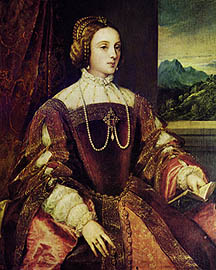
This portrait is a splendid example of Spanish/Portugese Tudor fashion. Isabella's gown is made of brown velvet, edged with bands of gold trim--either embroidered gold thread, or gold lace. The skirt opens to show an embroidered kirtle beneath. The large, satin-lined oversleeves, caught together at the front, reveal a form-fitting undersleeve, likely made of silk, composed of multiple puffs. The high-necked smock is embroidered in bands which radiate from the neck ruffle down to the curving top of the bodice.
Although the general sillouhete is the same as that of the preceding Portrait of Jane Seymour, a number of differences can be noted. The undersleeves are much less bulky and elaborate than Jane's, and the oversleeves lighter and not as full--Jane pins hers up to keep them out of the way and display the lining, while Isabella's gown sleeves are slashed open in the front and do not require special pinning or placement to keep them in order.
Many spanish portraits throughout the century show women's undersleeves gathered into a series of puffs, a fashion adopted by England in the later half of the 1500s. the portrait of Anne of Austria, Queen of Spain and Diane, Duchess de Guiche are two examples of the style.
Isabella's hair is also uncovered and elaborately dressed; something more commonly seen in Italian and Spanish portrats of the early 16th century than in English or Northern European portraits.
The exceedingly stiff line of this gown would necessitate very stiff interlining or boning of the bodice. This gown's bodice does not seem to open in the front, as does Jane Seymour's; although this could be artistic license rather than historical accuracy, it is likely that this gown laces at the back or the back side.